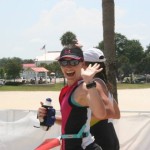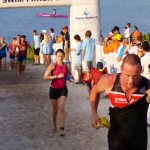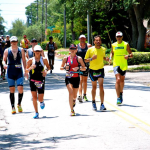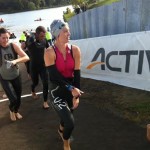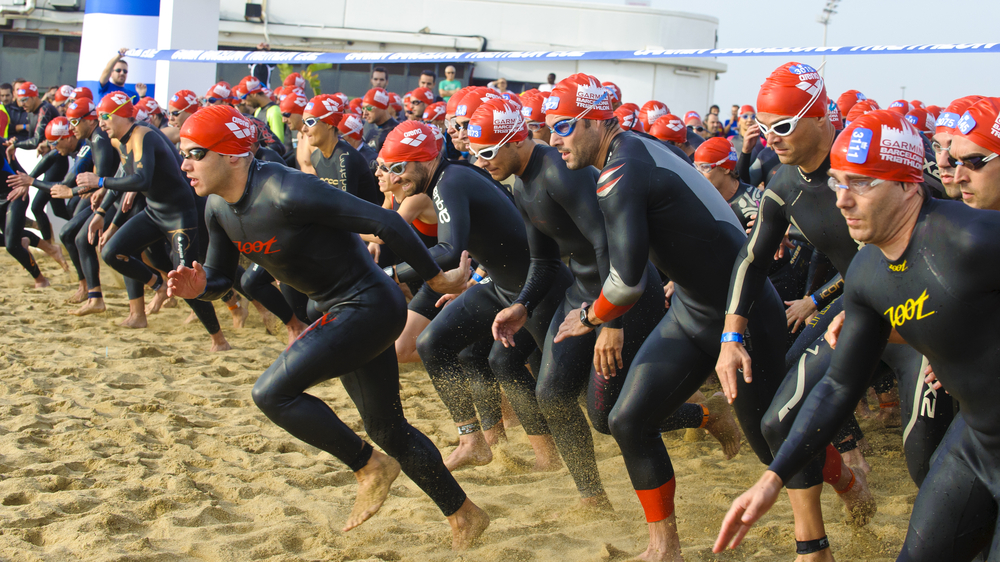Train for your first triathlon with the help of our new blogger, Amber!
Welcome to FN’s new triathlon training series! Over the next few months, Amber, our go-to tri training guru, will be sharing her wisdom and insight. She’s a runner turned age-group triathlete from Jacksonville, FL who is constantly trying to push the limits of her own body and mind through her various athletic endeavors.
A water buffalo. That is what I looked like when the first time I got in the pool to train for a triathlon. A heavy breathing, thrashing, slow, water buffalo.
As a lifelong runner with 5ks, 10ks, half-marathons, and a full marathon on my list of accomplishments, I was ready for a new challenge. For some reason, I decided that a triathlon would be it, because apparently one endurance sport just wasn’t difficult enough anymore. Before I could talk myself out of it, I registered for a local sprint triathlon three months out from that day. Immediately, I began worrying about the swim. My only experience in the water included drinking beer in an inner tube floating down a river (which I’m practically a professional at). Fast-forward to a year later, and I have four sprint triathlons, two Olympic distance triathlons, and two Ironman 70.3s under my belt. Here’s how you can do the same:
Get in the water!
Look for gyms with pools, colleges with pools open to the public, or community pools in your area. Specifically, see which pools have groups that meet and train there. I joined the University of North Florida’s branch of U.S. Masters Swimming and enjoyed 2-3 coached practices per week. These were pivotal in learning correct freestyle form, proper breathing, endurance, and speed.
Train in conditions similar to what you will encounter on race day.
Look for triathlon clubs or open-water swim groups in your area that meet for open-water swims. If there are no groups nearby, grab a friend and do some practice swims in the ocean or a lake. Practice sighting and swimming in a relatively straight line, and get used to conditions that are not found in the pool (waves, current, sun, etc.). Try to swim where there are lifeguards present as well.
Do not get discouraged.
Coach Carlos Mejia of the UNF Masters Swimming branch reminded me that it takes roughly 30 days to form a new habit. As a runner, do not get discouraged if swimming does not come naturally at first. Coach Carlos invited me to remember the differences between running and swimming, and build on the technique. You do not hold your breath when you run, and the leg motion for swimming is more of a forward kick versus a backwards stride that you use in running. It will feel awkward at first, but developing technique is the most important thing to consider as a new swimmer.
Remember that any forward motion during a race is acceptable.
That means you can backstroke, breaststroke, free-style, or doggie paddle to get through the swim. I stick to freestyle, but will engage in the breaststroke to catch my breath or to help with sighting to stay on course.
Practice disaster scenarios.
During the swim at an Olympic distance race, my goggles somehow slipped and filled with water. I had practiced flipping on my back, treading water, and putting my goggles back on in the pool, so this helped to avoid panic and got me back on track within a few seconds.
Start in the back or to the side of your wave.
I have always preferred to swim a little extra distance if it meant I could stay away from the center of the pack where the most swimmer-to-swimmer contact occurs.
Have fun!
Remember what made you sign up for a triathlon in the first place. Take it one stroke at a time, and be proud of your accomplishment.

